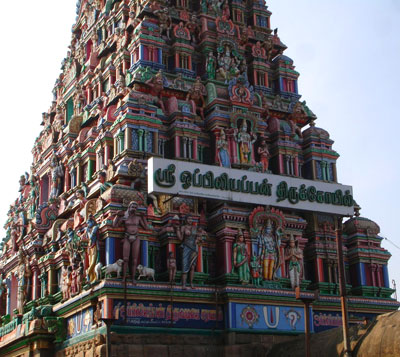Thirunageswaram Sri Oppiliappan Temple, Thanjavur

Address
Thirunageswaram Sri Oppiliappan Temple, Oppiliyappan koil N St, Thirunageswaram, Tamil Nadu 612204,Phone: 0435 246 3385
Deity
Oppliappan Perumal, Amman: Bhooma Devi
Introduction
- Location: Near Thirunageswaram, Kumbakonam, Tamil Nadu
- Deity Worshipped: Vishnu as Uppiliappan and his consort Lakshmi as Bhumi Devi
- Divya Desam: The 60th of the 108 Divya Desams dedicated to Vishnu
- Temple Architecture: Built in Dravidian style, the temple features a five-tiered rajagopuram (gateway tower) and is enclosed by a granite wall.
- Theertham: Ahotra Pushkarini
- Agama: Vaikanasam
Puranic Significance:
- The history of the temple is mentioned in the Brahmanda Purana. According to legend, Tulasi performed penance to get closer to Vishnu. Vishnu responded that Lakshmi would appear under the Tulasi plant in Thiruvinnagaram, the temple’s location. This is mentioned in the 53rd verse of Nammazhwaar’s Thiruviruththam.
- Markandeya Maharishi, desiring for Lakshmi to be his daughter and Vishnu his son-in-law, did penance for a thousand years. Lakshmi appeared as a baby under the Tulasi plant. When the girl reached adolescence, Vishnu appeared as an old man and asked for her hand in marriage. Markandeya, initially skeptical, realized it was Vishnu himself and offered his daughter’s hand. The Neyvethiyam (food offering) in the temple is always prepared without salt, symbolizing the marriage of Vishnu and Lakshmi in the legend.
- Another legend involves a king who, after consummating with a saint’s daughter, was cursed to become a bird. After a storm, the bird regained its human form when the tree branch it slept on fell into the Ahoraathra Pushkarani tank. The tank is believed to have healing powers at both day and night, hence its name.
Beliefs:
- Prayers at the temple are believed to bring unity among couples and foster qualities like tolerance and patience.
Special Features:
- The temple has a five-tiered rajagopuram and is surrounded by a granite wall, housing all the associated shrines and water bodies.
- The temple’s Sahasradhari plate and pot (kudam) are made of gold for performing Thirumanjanam (ablution) to the presiding deity.
- The temple maintains sacred items like a golden sword, diamond crown, and gold arm guard for the image of Hanuman.
- The main shrine enshrines Uppiliappan in a standing posture, with additional shrines for Bhoomidevi and Sage Markandeya.
- The vimana above the sanctum is called Suddhananda, meaning “pure happiness.”
- Other shrines in the temple complex include those dedicated to Anjaneya (on the southern side), Alwars and Sri Rama (on the northern side), Ramanuja (on the eastern side), and Garuda (opposite the sanctum).
- A shrine for Maniappan is located in the second precinct, with the shrines of Ennappan and Bhoomidevi’s holy birth spot on the northern side.
Festivals:
- Panguni Brahmotsavam (10-day festival) in March, starting with the flag hoisting ceremony.
Century/Period/Age
1000-2000 years old
Managed By
Hindu Religious and Charitable Endowments (HRCE)
Nearest Bus Station
Thirunageswaram
Nearest Railway Station
Kumbakkonam
Nearest Airport
Trichy




